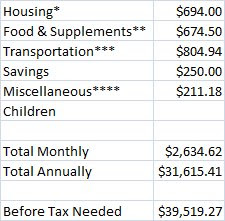The first problem to be addressed is that of the minimum payouts for UFC fighters. I believe the lowest payout figures to be released this year were a few $3000 show/win contracts like the one given to Goran Reljic at UFC 84. Many have been quick to criticize the UFC for these payouts as they question a fighter’s ability to make ends meet on such low income.
Following yesterday’s introduction, the interests of both parties are fairly obvious. A major interest of the fighters is to be able to provide for themselves and their families. And from a business perspective, it’s probably within the UFC’s interest to provide top-notch fights while also not having to pay anything more than it has to.
Talking about the interests of the fighters begs the question, what kind of expenses do they need to provide for? Therefore, taking into consideration monthly expenses such as the money spent on housing, food & supplements, transportation, and saving contributions I have come up with the following rough, yearly before tax requirement that fighters need to meet in order to be financially secure:
A simple estimate of fighter expenses on a monthly basis (see footnotes following article for explanation of estimate) makes it easy to see why the minimum payouts need to be raised in order to meet their interests (some would call them basic needs). A fighter signed to one of these $3,000 show/win contracts that fights four times a year is lucky to make $24,000 before tax.
Keep in mind that there are discretionary and other performance bonuses in a fighters contract, but that they are in no way guaranteed. The sponsorship money for low-end fighters has to be considered minimal, although to be fair there really aren’t a lot of estimates kicking around right now. Also, the industry standard for an agent’s percentage of a fighter’s purse is around 20%.
All of the above were not included in the monthly expense calculations because ultimately they were not necessary to prove my point. However, they deserve mention as additional food for thought.
The Solution
Get rid of the show/win contracts altogether by moving to a flat-fee and institute a minimum fight payout for all UFC contracts at $10,000/fight.
How does this meet the interests of the fighters?
First and foremost, a UFC contracted fighter entering the octagon four times per year will earn $40,000 before tax and have sufficient funds to cover most of his living expenses. This minimum payout will allow the lower echelon fighters to improve their standard of living and hopefully help them commit to fighting as a full-time occupation.
How does this meet the interests of the UFC?
The additional amount spent on minimum fight payouts would seem to initially contradict the UFC’s interest to spend nothing more than it has to. However, at a second glance the additional amount spent on fighter payouts is rather minimal. If Dana White is correct in his estimate that nearly 75% of UFC fighters make less than $50,000/year, that also means that 25% of UFC fighters stand to benefit from an increase in the minimum payouts. Thus, if the maximum number of fights on a UFC card is 12 that would mean 6 fighters would stand to receive a maximum of $42,000 ($10,000-$3,000 x 6) in additional payout money. That’s 3.1746% of UFC 84’s total fighter payout and 0.3310% of UFC 84’s estimated gross revenue.
If in business you have to spend some money to make some money, spending money on your human capital is always a wise choice. For years business academia have been studying the impact of employee satisfaction on a company’s financial success, as well as customer satisfaction. Generally what they’ve found is a positive correlation between employee satisfaction and firm success. And really, it’s just common sense in many ways: if the fighters are content with their situation, they’re free to focus on their training and upcoming fight preparations. This increase in commitment is likely to create a better overall fight product for the UFC, which is very much in its interest.
Some might be quick to argue that eliminating the show/win contract by moving to flat-fees will reduce the level of competition within the UFC because an element of incentive has been removed. I, however, would argue that, if anything, the level of competition in the fighter ranks is going to improve.
Recent roster cuts have made it abundantly clear that only the best and most exciting fighters will remain in the UFC; this makes the incentive of the show/win contract more or less obsolete. And, if the roster cuts weren’t enough, the growing size of the discretionary bonuses given out at the end of each event present more than enough extra incentive for the fighters to come out and put on an exciting show.
Furthermore, an increased minimum payout is going to attract more attention from emerging fighters that have a lot of options at the moment. At the same time, it squeezes some of the UFC’s more financially volatile competition that cannot afford to raise its minimum payouts. Both of which are obviously in the interest of the UFC.
Footnotes to Estimated Fighter Expenses Chart:
* The housing figure is derived from the median renting number within the latest AHS census from 2006.
** Food & Supplements were derived from a combination of the average food expenditure from the 2005 Consumer Expenditure Survey and a $150 supplement cost (which is likely a pretty low estimate).+++ As many of these fighters are family-men, also consider the additional monthly expense for children. The ballpark monthly expense could probably be pegged around $450 for one child and somewhere around $700 for two. Child support payments can be used as a good reference.
*** Transportation was also derived from the 2005 Consumer Expenditure Survey and likely includes fuel, vehicle payments, maintenance, etc.
**** Miscellaneous includes entertainment and other odd expenditures all taken from the 2005 Consumer Expenditure Survey.



Leave a Reply